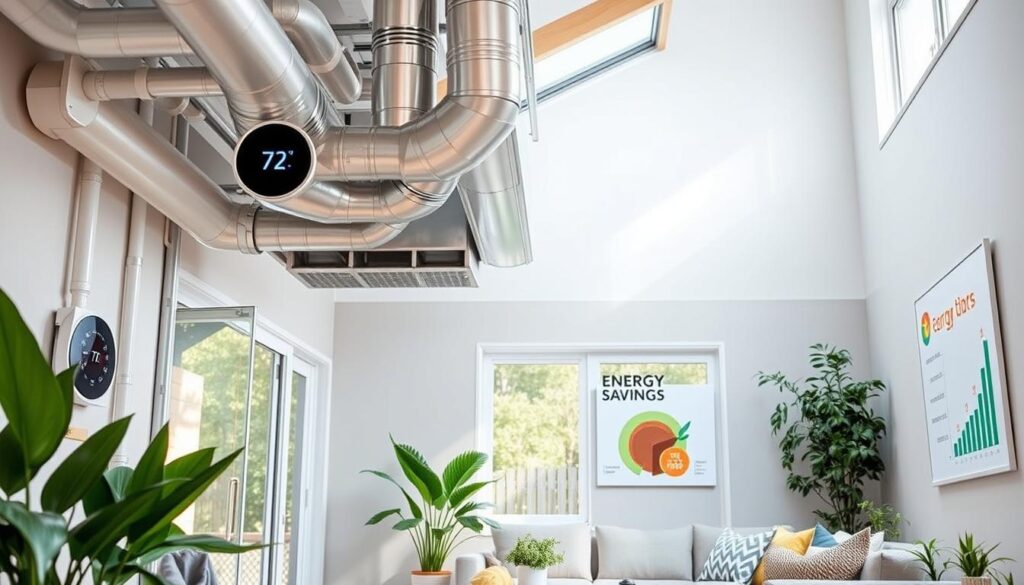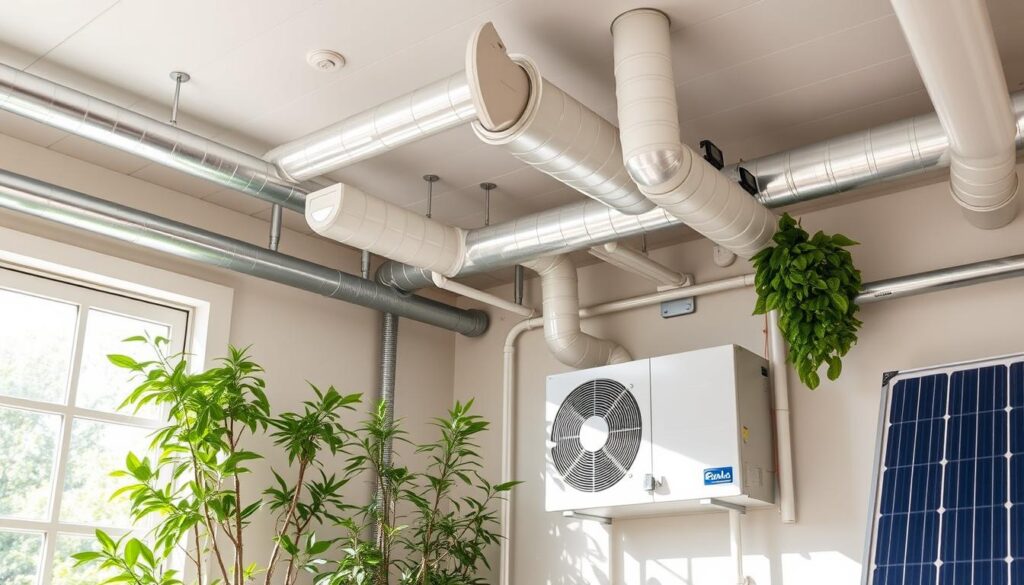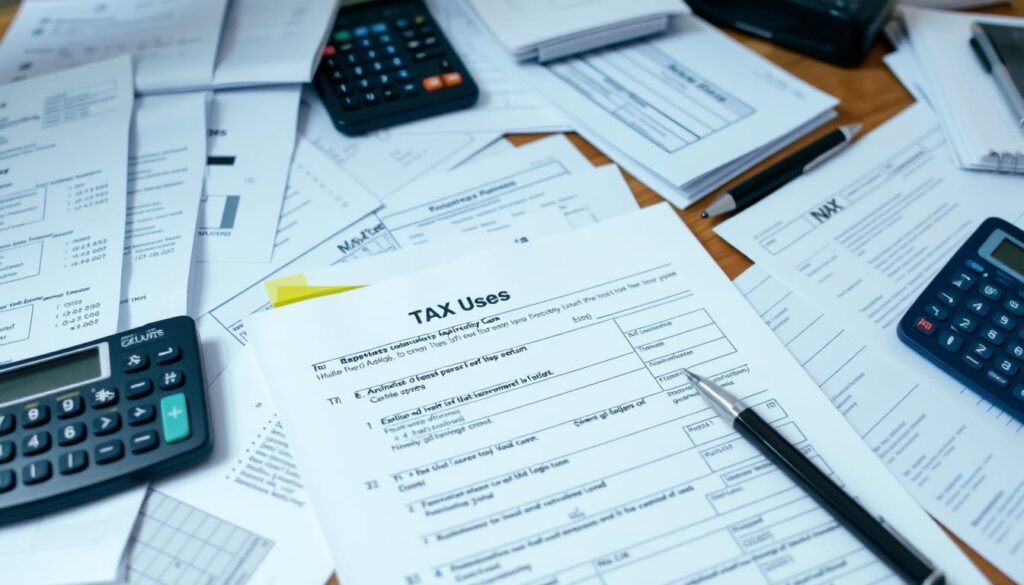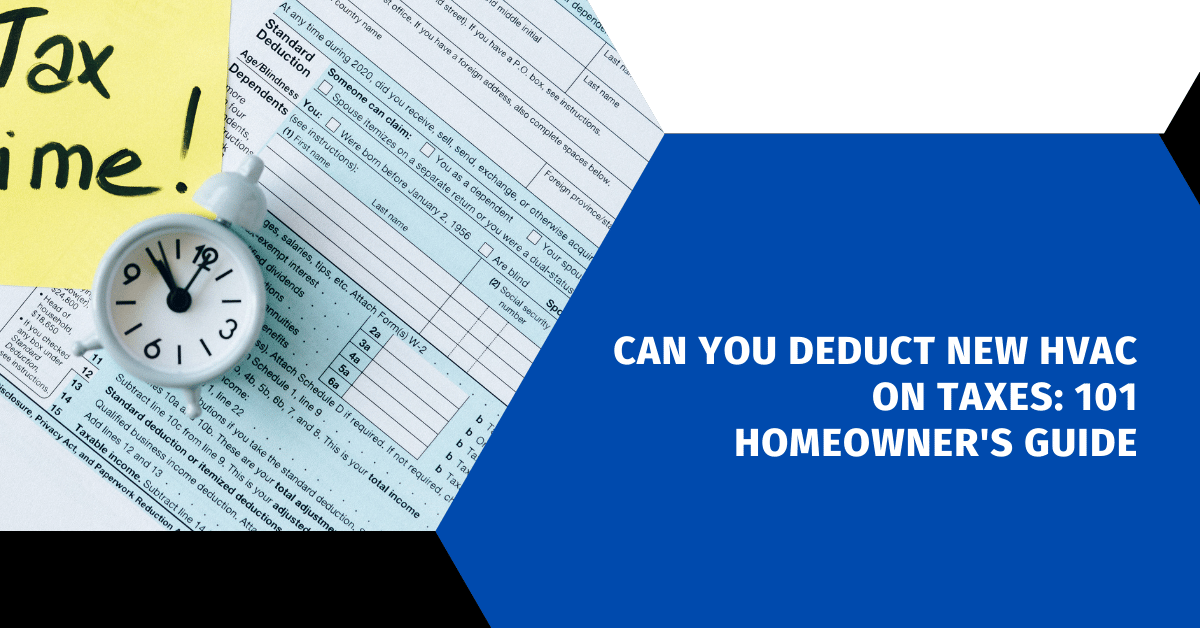Affiliate Disclosure
HVAC Guide Guys is a participant in the Amazon Services LLC Associates Program, an affiliate advertising program designed to provide a means for sites to earn advertising fees by advertising and linking to Amazon.
Can You Deduct New HVAC on Taxes? Did you know homeowners can get up to $3,200 in tax credits for energy-efficient upgrades? This includes new HVAC systems installed from 2023 to 2032. The credit is 30% of the cost, with limits for different upgrades. Knowing how to save on taxes with new HVAC is key.
This guide will walk you through tax deductions and credits for HVAC upgrades. You’ll learn how to make smart choices and use available incentives. By the end, you’ll know what you need to claim your HVAC tax credits.

Key Takeaways
- The Energy Efficient Home Improvement Credit offers up to $3,200 in tax credits for qualified HVAC upgrades installed between 2023 and 2032.
- The credit equals 30% of the installation costs, with specific limits for different types of energy-efficient improvements.
- Eligible HVAC systems include air conditioners, heat pumps, furnaces, and boilers that meet efficiency standards.
- Homeowners must meet specific criteria, such as installing upgrades in their primary residence, to qualify for the tax credits.
- Careful documentation and adherence to reporting requirements are crucial for claiming the HVAC-related tax credits.
Table of Contents
Understanding Tax Credits for HVAC Improvements
The Inflation Reduction Act of 2022 has made it easier for homeowners to get tax credits for energy-saving home upgrades. This includes better HVAC systems. These credits can help lower the cost of installing efficient air conditioners, furnaces, and heat pumps.
What Qualifies as an Energy-Efficient Home Improvement?
Home improvements that qualify for tax credits include:
- Heat pumps (air-source and geothermal)
- Central air conditioning systems
- Furnaces and boilers
- Biomass stoves
These systems must meet certain energy standards. They need to be ENERGY STAR certified and have specific SEER, HSPF, and AFUE ratings.
The Inflation Reduction Act Overview
The Inflation Reduction Act, passed in 2022, boosted and extended tax credits for energy-saving home upgrades. It also brought in new rebate programs. For example, the High-Efficiency Electric Home Rebate Act offers up to $8,000 for electric heat pumps.
Credit Availability Timeline: 2023-2032
The tax credits for energy-saving home upgrades, like HVAC, are available from 2023 to 2032. The credit rate is 30% of the total cost. There are yearly limits of $1,200 to $2,000, depending on the equipment. In 2033 and 2034, the credit rates will drop to 26% and 22%, respectively.
Explore Our HVAC Shop
Looking for top-rated HVAC tools, parts, and accessories? Visit our shop and find the perfect solution for your needs.
Visit the ShopMaximum Tax Credit Amounts and Limitations
The Inflation Reduction Act (IRA) has improved tax credits for energy-efficient home upgrades. Homeowners can get up to $1,200 per year for energy-efficient property and home improvements. There are also credits of up to $2,000 per year for installing heat pumps, water heaters, and biomass stoves or boilers.
The residential energy property credit offers a tax deduction of up to $600 per item. This includes qualified windows, skylights, and exterior doors. For bigger investments, like heat pumps and biomass stoves, the credit can be $2,000 per year. There’s no limit on the credits, so homeowners can claim the maximum each year until 2033.
| Energy-Efficient Improvement | Maximum Tax Credit |
|---|---|
| Energy-Efficient Property (e.g., insulation, windows, doors) | $1,200 per year |
| Heat Pumps, Water Heaters, Biomass Stoves/Boilers | $2,000 per year |
| Exterior Doors | $250 per door, $500 total |
| Windows and Skylights | $600 |
| Home Energy Audits | $150 |
The tax credits are non-refundable. This means you won’t get a refund if your tax liability is $0. They also only apply to your primary residence in the U.S. Not for new construction or rental properties. Talking to a tax professional can help you get the most from these credits.
Qualifying HVAC Systems and Equipment
The Inflation Reduction Act of 2023 changed HVAC tax credits a lot. It increased the credit amount, made it last longer, and included more systems. Now, HVAC tax credits in 2023 help make homes more energy-efficient. This includes advanced heat pumps, air conditioners, and furnaces.
Heat Pumps and Associated Credits
Heat pumps need to be very efficient to get tax credits. They must have a SEER2 rating of 16 or more, an EER2 rating of 12 or more, and an HSPF2 rating of 9 or more. Homeowners can get a $2,000 tax credit for these efficient heat pumps.
Central Air Conditioning Systems
Central air conditioners can also get tax credits. They need a SEER2 rating of 16 or more to qualify. Homeowners can get a $600 tax credit for these efficient air conditioners.
Furnaces and Boilers
Gas furnaces must be ENERGY STAR-certified and have an AFUE rating of 97% or higher. Oil furnaces need to be approved for biofuel blends. Boilers require different standards based on their fuel type. Gas boilers need an AFUE of 95% or higher to qualify.
Homeowners should talk to tax experts and keep records of their purchases and installations. This way, they can claim the full credit for their energy-efficient HVAC systems on their taxes.
Explore Our HVAC Shop
Looking for top-rated HVAC tools, parts, and accessories? Visit our shop and find the perfect solution for your needs.
Visit the ShopEnergy Efficiency Standards for Tax Deductions
When you upgrade your HVAC, the energy efficiency matters for tax deductions. The tax credits depend on ratings like SEER2, EER2, HSPF2, and AFUE. These ratings show how well your air conditioners, heat pumps, and furnaces work.
To get the tax credits, your systems must meet certain efficiency levels. An Energy Star certification is also a good sign. It means your equipment is likely to qualify for the tax deductions.
| Efficiency Metric | Minimum Requirement |
|---|---|
| SEER2 | ≥ 15 |
| EER2 | ≥ 12.1 |
| HSPF2 | ≥ 8.2 |
| AFUE | ≥ 95% |
Make sure your new HVAC equipment meets these standards. This way, you can get the most tax deductions when you upgrade your home’s heating and cooling.

Can You Deduct New HVAC on Taxes: Credit Calculation
Upgrading your home’s HVAC system can lead to tax savings. The federal government offers a tax credit of 30% of the cost of energy-efficient HVAC upgrades. This includes the installation costs.
Understanding the 30% Credit Rate
The tax credit is 30% of the total cost of eligible HVAC upgrades. For instance, a $1,000 investment in a new air conditioner could get you a $300 tax credit. This helps reduce the upfront costs of energy-efficient HVAC systems.
Installation Cost Considerations
- Installation costs are usually included in the tax credit for most HVAC upgrades, except for insulation.
- Your new HVAC system must meet energy efficiency standards from the Inflation Reduction Act. This includes a SEER2 rating of 16 for heat pumps.
- Remember, there are yearly limits on tax credit amounts based on the HVAC equipment type.
Understanding how to calculate the tax credit and what expenses qualify can help you save more. This is especially true when upgrading to an energy-efficient HVAC system for your home.
Explore Our HVAC Shop
Looking for top-rated HVAC tools, parts, and accessories? Visit our shop and find the perfect solution for your needs.
Visit the ShopRequired Documentation for Tax Claims
When you upgrade your HVAC system, keeping detailed records is key. You’ll need these for your tax return. This ensures you get the most deductions possible.
To claim the HVAC tax credits, you’ll need to gather the following documentation:
- Receipts and invoices for the HVAC system and installation costs
- Manufacturer certification statements that prove the efficiency of your new HVAC equipment
- A completed IRS Form 5695 (Residential Energy Credits), which you’ll attach to your Form 1040 or 1040-SR when filing your income taxes
Starting in 2025, each qualifying HVAC item will also require a specific manufacturer’s PIN to be eligible for the tax credit. This ensures the credits are being claimed for verified, energy-efficient products.
By staying organized and maintaining meticulous tax documentation, you’ll maximize your chances of successfully claiming the available HVAC tax credits and reducing your overall tax burden.

Primary Residence Requirements and Limitations
The energy-efficient home improvement tax credit aims to encourage homeowners to upgrade their homes. It applies only to the main home in the United States. This means it doesn’t cover vacation homes, rental properties, or other secondary homes.
To get the tax credit, the home must be the homeowner’s main residence. They must live there for most of the year. The credit is not for homes used mainly for business, like a home office or rental property.
Business Use Considerations
If part of the home is for business, the tax credit is still available. But, the amount depends on the home’s non-business use. For instance, if 20% is for business, the credit is for 80% of the home.
Rental Property Restrictions
Rental properties usually can’t get the energy-efficient home improvement tax credit. It’s meant for homeowners upgrading their primary residences, not for investment properties. Landlords or property owners who don’t live in the home can’t claim the tax credit.
Homeowners need to know these rules before making energy-efficient upgrades. This way, they can understand the tax credits they might get.
State and Local Incentives for HVAC Upgrades
Homeowners can save a lot by using federal tax credits and state and local incentives. These savings can greatly reduce the cost of making their homes more energy-efficient.
Many states offer tax deductions or credits for high-efficiency HVAC upgrades. For instance, Idaho gives a 40% tax deduction for certain energy equipment. This can be up to $5,000 per year, spread over four years.
Homeowners should also look into local utility rebates. Programs like the Home Energy Performance-Based Whole-House Rebate offer $2,000 to $4,000 for energy-saving upgrades. The High-Efficiency Electric Home Rebate can cover up to $14,000 for low- and middle-income families.
To get the most savings, homeowners should check out state tax incentives, local rebates, and additional HVAC savings programs. Talking to local HVAC experts can help find all the financial help available.
| Incentive Program | Description | Maximum Savings |
|---|---|---|
| Idaho Tax Deduction | 40% deduction for solar, wind, geothermal, and certain biomass equipment | $5,000 per year, over 4 years |
| Home Energy Performance-Based Whole-House Rebate | Rebates for energy-efficient home retrofits | $2,000 to $4,000 |
| High-Efficiency Electric Home Rebate | Covers 100% of electrification project costs for low-income, 50% for middle-income | Up to $14,000 per household |
By using federal and state/local incentives, homeowners can lower the cost of new HVAC systems. This leads to long-term savings and a greener home.
Explore Our HVAC Shop
Looking for top-rated HVAC tools, parts, and accessories? Visit our shop and find the perfect solution for your needs.
Visit the ShopCommon Mistakes to Avoid When Claiming HVAC Tax Credits
Homeowners should be careful when claiming tax credits for energy-efficient HVAC upgrades. Tax credit errors, claim mistakes, and IRS compliance issues can reduce your savings. It’s important to avoid these pitfalls.
One mistake is not meeting the strict efficiency standards. Your new HVAC system must meet the Inflation Reduction Act’s criteria. Also, forgetting to keep receipts and installation dates can harm your claim.
Another error is not understanding the credit limits. The Energy Efficient Home Improvement Credit can be up to $1,200 from 2023 to 2032. There’s an extra $2,000 for qualified heat pumps and biomass systems. It’s key to calculate your credit correctly to avoid mistakes.
- Ensure your HVAC system meets the required energy-efficiency standards
- Maintain detailed records of your purchase and installation dates
- Understand the maximum credit limits and calculate your claim accordingly
- Claim the credit in the tax year the equipment was installed, not purchased
By avoiding these common tax credit errors and claim mistakes, you can ensure IRS compliance. This way, you can fully benefit from the energy-efficient HVAC tax credits. Proper planning and documentation are essential for a successful claim and to avoid IRS issues.
Conclusion
Homeowners in the United States can save a lot by improving their HVAC systems. Investing in energy-efficient systems can lead to big savings. You can get federal, state, and local rebates and tax credits.
These incentives can help lower the upfront costs. They also lead to long-term energy savings and better home comfort.
It’s important to know the rules and requirements for these savings. Whether you’re getting a new heat pump or a central air system, these incentives can help. They make the cost more manageable and rewarding.
Choosing energy-efficient HVAC systems has many benefits. You get HVAC tax savings and help the environment. With energy efficiency benefits and homeowner incentives, now is a great time to upgrade your HVAC.
FAQ
What qualifies as an energy-efficient home improvement?
What is the timeline for the energy-efficient home improvement tax credits?
What are the maximum tax credit amounts and limitations?
What qualifies as an energy-efficient home improvement?
What is the timeline for the energy-efficient home improvement tax credits?
What are the maximum tax credit amounts and limitations?
FAQ
What qualifies as an energy-efficient home improvement?
Home improvements that qualify include heat pumps, central air conditioners, and biomass stoves. They must meet certain efficiency standards. The Inflation Reduction Act of 2022 made these credits more accessible. It focuses on the Energy Efficient Home Improvement Tax Credit (25C) and Section 25D for homes.
What is the timeline for the energy-efficient home improvement tax credits?
You can get the tax credits for improvements made from 2023 to 2032. In 2033 and 2034, the rates will be lower.
What are the maximum tax credit amounts and limitations?
The maximum credit is
FAQ
What qualifies as an energy-efficient home improvement?
Home improvements that qualify include heat pumps, central air conditioners, and biomass stoves. They must meet certain efficiency standards. The Inflation Reduction Act of 2022 made these credits more accessible. It focuses on the Energy Efficient Home Improvement Tax Credit (25C) and Section 25D for homes.
What is the timeline for the energy-efficient home improvement tax credits?
You can get the tax credits for improvements made from 2023 to 2032. In 2033 and 2034, the rates will be lower.
What are the maximum tax credit amounts and limitations?
The maximum credit is $1,200 for certain home improvements and energy-efficient properties. There are limits for exterior doors, windows, skylights, and home energy audits. An extra $2,000 is available for heat pumps, water heaters, and biomass stoves or boilers.
What HVAC systems and equipment qualify for the tax credits?
HVAC systems must meet specific efficiency standards to qualify. Heat pumps get a $2,000 credit if they have SEER2 ≥ 16, EER2 ≥ 12, and HSPF2 ≥ 9. Central air conditioners need SEER2 ≥ 16 for a $600 credit. Gas furnaces must be Energy Star-certified with AFUE ≥ 97%, while oil furnaces need specific biofuel blends. Boilers require different standards based on fuel type, with gas boilers needing AFUE ≥ 95%.
What energy efficiency standards are used for HVAC tax deductions?
The standards are based on ratings like SEER2, EER2, HSPF2, and AFUE. These ratings measure energy efficiency.
How is the tax credit calculated for HVAC improvements?
The tax credit is 30% of the cost of qualified improvements, including installation. The credit has annual limits based on the improvement type.
What documentation is required to claim HVAC tax credits?
Homeowners need to keep records of installation costs, like receipts and invoices. They also need manufacturer certification statements for efficiency. IRS Form 5695 (Residential Energy Credits) must be completed and attached to Form 1040 or 1040-SR when filing.
What are the requirements for the primary residence and limitations for business use or rental properties?
The credit is for the homeowner’s main residence in the U.S. If a home is used for business, full credit is available for up to 20% business use. Beyond that, the credit is prorated. Rental properties usually don’t qualify for these credits.
Are there any state and local incentives available for HVAC upgrades?
Yes, many states and local utilities offer incentives for energy-efficient HVAC upgrades. This includes rebates, low-interest loans, or additional tax credits. Homeowners should look into state programs and talk to local HVAC experts to save more.
What are some common mistakes to avoid when claiming HVAC tax credits?
Avoid not meeting efficiency standards, not keeping proper records, misunderstanding credit limits, and overlooking installation date requirements. Make sure to claim the credit in the tax year the equipment was installed, not purchased.
,200 for certain home improvements and energy-efficient properties. There are limits for exterior doors, windows, skylights, and home energy audits. An extra ,000 is available for heat pumps, water heaters, and biomass stoves or boilers.
What HVAC systems and equipment qualify for the tax credits?
HVAC systems must meet specific efficiency standards to qualify. Heat pumps get a ,000 credit if they have SEER2 ≥ 16, EER2 ≥ 12, and HSPF2 ≥ 9. Central air conditioners need SEER2 ≥ 16 for a 0 credit. Gas furnaces must be Energy Star-certified with AFUE ≥ 97%, while oil furnaces need specific biofuel blends. Boilers require different standards based on fuel type, with gas boilers needing AFUE ≥ 95%.
What energy efficiency standards are used for HVAC tax deductions?
The standards are based on ratings like SEER2, EER2, HSPF2, and AFUE. These ratings measure energy efficiency.
How is the tax credit calculated for HVAC improvements?
The tax credit is 30% of the cost of qualified improvements, including installation. The credit has annual limits based on the improvement type.
What documentation is required to claim HVAC tax credits?
Homeowners need to keep records of installation costs, like receipts and invoices. They also need manufacturer certification statements for efficiency. IRS Form 5695 (Residential Energy Credits) must be completed and attached to Form 1040 or 1040-SR when filing.
What are the requirements for the primary residence and limitations for business use or rental properties?
The credit is for the homeowner’s main residence in the U.S. If a home is used for business, full credit is available for up to 20% business use. Beyond that, the credit is prorated. Rental properties usually don’t qualify for these credits.
Are there any state and local incentives available for HVAC upgrades?
Yes, many states and local utilities offer incentives for energy-efficient HVAC upgrades. This includes rebates, low-interest loans, or additional tax credits. Homeowners should look into state programs and talk to local HVAC experts to save more.
What are some common mistakes to avoid when claiming HVAC tax credits?
Avoid not meeting efficiency standards, not keeping proper records, misunderstanding credit limits, and overlooking installation date requirements. Make sure to claim the credit in the tax year the equipment was installed, not purchased.

